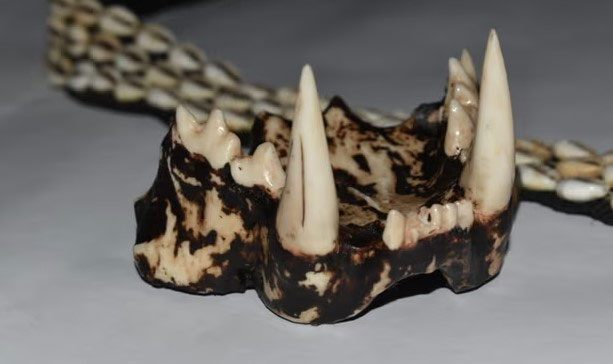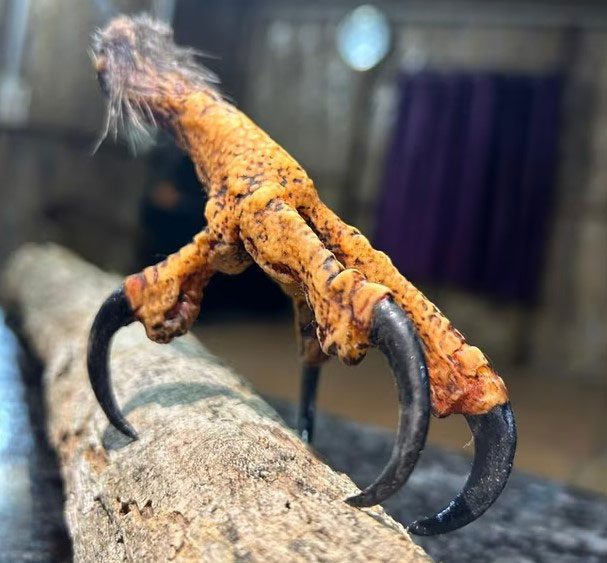A startup in India has utilized 3D printing technology to create models of various body parts of wildlife, providing a solution to help protect these creatures.
In Arunachal Pradesh, a state in Northeast India, animals such as tigers, leopards, eagles, and hornbills are often scattered throughout the tropical forests. However, this area is also home to the Nyishi community—the largest indigenous tribe in Arunachal Pradesh.
Traditionally, men in this region wear a byopa—a type of hat made from hand-woven rattan. A distinctive feature of the byopa is that it is adorned with the beak and upper horn of a hornbill on the front and an eagle’s claw at the back. Additionally, the men of the tribe often carry a machete attached to a jawbone of tigers or leopards.

A 3D printed leopard tooth product. (Source: Arunachal Ivory and Ornaments)
Nabam Bapu, a Nyishi entrepreneur currently residing in Papum Pare district of Arunachal Pradesh, stated: “The people here believe that the tiger rules the forest and the eagle rules the sky. Thus, wearing parts of these animals enhances their spirit and gives them a sense of security.”
However, for Bapu, hunting rare animals for their body parts is a significant concern, especially as the number of wildlife in Arunachal Pradesh is declining. Therefore, in January 2020, Bapu, along with a friend—Anang Tadar, an innovator in technology—proposed a solution: to apply 3D printing technology to produce models of body parts from rare wildlife.
Tadar shared: “We spent two years sourcing raw materials for the products, from synthetic plastics to wood and fire-resistant glass. Currently, we are also exploring the benefits of plant-based, environmentally friendly plastics.”
This project is one of the few in the world aimed at preserving the cultural traditions of indigenous communities while also addressing the alarming exploitation of wildlife.
In South Africa, in 2013, Panthera—a charity focused on conserving wild cat species—launched the “Furs for Life” campaign. This campaign focused on using synthetic fur to replace real leopard skin for producing amambatha coats—a cultural emblem of indigenous communities in South Africa. According to Panthera’s estimates, this project has helped reduce the consumption of real leopard skins for producing amambatha coats by 50%.
Currently, once a month, Bapu and Tadar walk along a long route, bringing the latest samples they produce to seek the opinions of Nyishi elders. “Getting the feedback from the elders is a crucial step. Only they can accurately assess the authenticity of the sample products we create, as they have years of hunting experience,” Tadar explained.
To date, Arunachal Ivory and Ornaments—the startup founded by Bapu along with Likha Nana, a historian and his wife—has produced over 100 models of fangs from leopards, tigers, wild boars, and eagle claws. The company continues to develop additional 3D prints resembling the beak of the hornbill native to India.
Arunachal Pradesh is home to 26 major tribes, including Nyishi, Adi, Galo, Apatani, and Tagin. As the cultural practices and traditions of these tribes show signs of decline, the government of Arunachal Pradesh encourages residents to wear traditional attire regularly. This has led to an increasing demand for wildlife body parts.
“Not everyone can afford to buy wildlife body parts. You wouldn’t believe how much a tiger tooth can sell for on the black market—it ranges from 400,000 to 500,000 rupees (approximately $4,800 to $6,000),” Bapu remarked.

Eagle claw produced using 3D printing technology. (Source: Arunachal Ivory and Ornaments).
Under the current circumstances, global authorities are still working hard to combat illegal hunting and wildlife trafficking. Tana Tapi, Deputy Director of the Wildlife Monitoring and Conservation Agency in Arunachal Pradesh, observed: “Monitoring illegal hunting activities will be very challenging,” especially since Arunachal Pradesh shares its eastern border with Myanmar and its northern border with China.
In light of this situation, Arunachal Ivory and Ornaments hopes to contribute to the fight against wildlife trafficking. Rajkamal Goswami, a researcher with over 10 years of experience in conservation in Northeast India, stated: “The success of the new product will depend on public acceptance. Every business should strive to persuade influential local organizations to support such products to reduce the level and intensity of wildlife hunting.”
Bapu believes that what his company is doing can significantly improve the current situation: “Instead of using high-tech guns to cruelly kill wildlife, why don’t we use modern technology for more practical and humane purposes, such as conserving wildlife and restoring the cultural values that are gradually disappearing?”.


















































